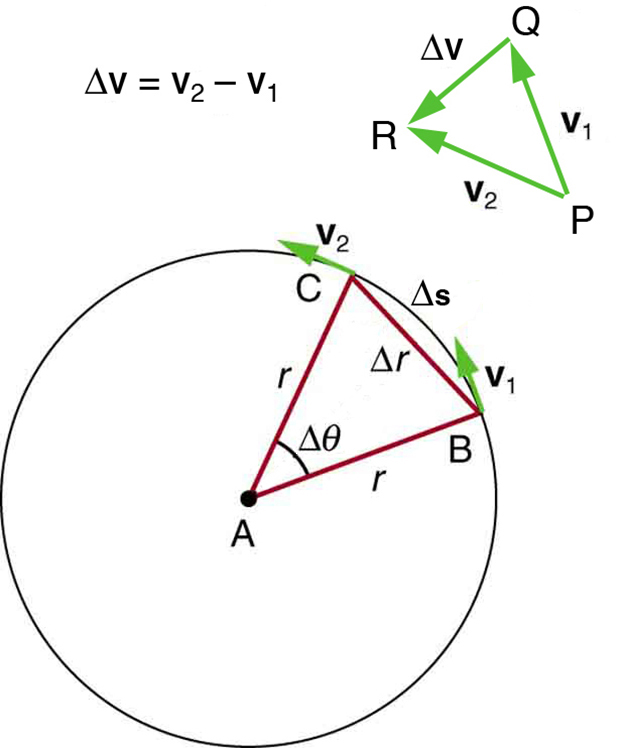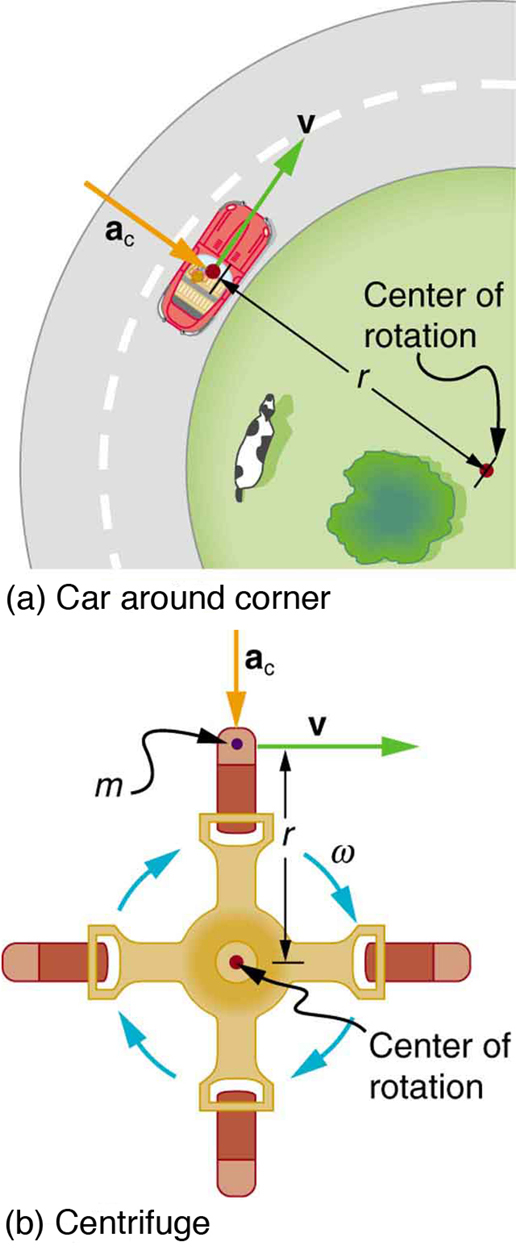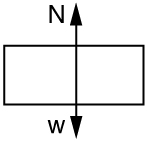Chapter 6 Uniform Circular Motion and Gravitation
6.2 Centripetal Acceleration
Summary
- Establish the expression for centripetal acceleration.
- Explain the centrifuge.
We know from kinematics that acceleration is a change in velocity, either in its magnitude or in its direction, or both. In uniform circular motion, the direction of the velocity changes constantly, so there is always an associated acceleration, even though the magnitude of the velocity might be constant. You experience this acceleration yourself when you turn a corner in your car. (If you hold the wheel steady during a turn and move at constant speed, you are in uniform circular motion.) What you notice is a sideways acceleration because you and the car are changing direction. The sharper the curve and the greater your speed, the more noticeable this acceleration will become. In this section we examine the direction and magnitude of that acceleration.
Figure 1 shows an object moving in a circular path at constant speed. The direction of the instantaneous velocity is shown at two points along the path. Acceleration is in the direction of the change in velocity, which points directly toward the center of rotation (the center of the circular path). This pointing is shown with the vector diagram in the figure. We call the acceleration of an object moving in uniform circular motion (resulting from a net external force) the centripetal acceleration( [latex]{a_{{c}}}[/latex] ); centripetal means “toward the center” or “center seeking.”

The direction of centripetal acceleration is toward the center of curvature, but what is its magnitude? Note that the triangle formed by the velocity vectors and the one formed by the radii [latex]{r}[/latex] and [latex]{\Delta{s}}[/latex] are similar. Both the triangles ABC and PQR are isosceles triangles (two equal sides). The two equal sides of the velocity vector triangle are the speeds [latex]{v_1=v_2=v}.[/latex] Using the properties of two similar triangles, we obtain
Acceleration is [latex]{\Delta{v}/\Delta{t}},[/latex] and so we first solve this expression for [latex]{\Delta{v}}:[/latex]
Then we divide this by [latex]{\Delta{t}},[/latex] yielding
Finally, noting that [latex]{\Delta{v}/\Delta{t}=a_{\text{c}}}[/latex] and that [latex]{\Delta{s}/\Delta{t}=v},[/latex] the linear or tangential speed, we see that the magnitude of the centripetal acceleration is
which is the acceleration of an object in a circle of radius [latex]{r}[/latex] at a speed [latex]{v}.[/latex] So, centripetal acceleration is greater at high speeds and in sharp curves (smaller radius), as you have noticed when driving a car. But it is a bit surprising that [latex]{a_{\text{c}}}[/latex] is proportional to speed squared, implying, for example, that it is four times as hard to take a curve at 100 km/h than at 50 km/h. A sharp corner has a small radius, so that [latex]{a_{\text{c}}}[/latex] is greater for tighter turns, as you have probably noticed.
It is also useful to express [latex]{a_{\text{c}}}[/latex] in terms of angular velocity. Substituting [latex]{v=r\omega}[/latex] into the above expression, we find [latex]{a_{\text{c}}=(r\omega)^2/r=r\omega^2}.[/latex] We can express the magnitude of centripetal acceleration using either of two equations:
Recall that the direction of [latex]{a_{\text{c}}}[/latex] is toward the center. You may use whichever expression is more convenient, as illustrated in examples below.
A centrifuge (see Figure 2b) is a rotating device used to separate specimens of different densities. High centripetal acceleration significantly decreases the time it takes for separation to occur, and makes separation possible with small samples. Centrifuges are used in a variety of applications in science and medicine, including the separation of single cell suspensions such as bacteria, viruses, and blood cells from a liquid medium and the separation of macromolecules, such as DNA and protein, from a solution. Centrifuges are often rated in terms of their centripetal acceleration relative to acceleration due to gravity [latex]{(g)};[/latex] maximum centripetal acceleration of several hundred thousand [latex]{g}[/latex] is possible in a vacuum. Human centrifuges, extremely large centrifuges, have been used to test the tolerance of astronauts to the effects of accelerations larger than that of Earth’s gravity.
Example 1: How Does the Centripetal Acceleration of a Car Around a Curve Compare with That Due to Gravity?
What is the magnitude of the centripetal acceleration of a car following a curve of radius 500 m at a speed of 25.0 m/s (about 90 km/h)? Compare the acceleration with that due to gravity for this fairly gentle curve taken at highway speed. See Figure 2(a).
Strategy
Because [latex]{v}[/latex] and [latex]{r}[/latex] are given, the first expression in [latex]{a_{\text{c}}=\frac{v^2}{r};\:a_{\text{c}}=r\omega^2}[/latex] is the most convenient to use.
Solution
Entering the given values of [latex]{v=25.0\text{ m/s}}[/latex] and [latex]{r=500\text{ m}}[/latex] into the first expression for [latex]{a_{\text{c}}}[/latex] gives
Discussion
To compare this with the acceleration due to gravity [latex]{(g=9.80\text{ m/s}^2)},[/latex] we take the ratio of [latex]{a_{\text{c}}/g=(1.25\text{ m/s}^2)/(9.80\text{ m/s}^2)=0.128}.[/latex] Thus, [latex]{a_{\text{c}}=0.128\text{ g}}[/latex] and is noticeable especially if you were not wearing a seat belt.

Example 2: How Big Is The Centripetal Acceleration in an Ultracentrifuge?
Calculate the centripetal acceleration of a point 7.50 cm from the axis of an ultracentrifuge spinning at [latex]{7.5\times10^4\text{ rev/min}}.[/latex] Determine the ratio of this acceleration to that due to gravity. See Figure 2(b).
Strategy
The term rev/min stands for revolutions per minute. By converting this to radians per second, we obtain the angular velocity [latex]{\omega}.[/latex] Because [latex]{r}[/latex] is given, we can use the second expression in the equation [latex]{a_{\text{c}}=\frac{v^2}{r};\:a_{\text{c}}=r\omega^2}[/latex] to calculate the centripetal acceleration.
Solution
To convert [latex]{7.5\times10^4\text{ rev/min}}[/latex] to radians per second, we use the facts that one revolution is [latex]{2\pi\text{rad}}[/latex] and one minute is 60.0 s. Thus,
Now the centripetal acceleration is given by the second expression in [latex]{a_{\text{c}}=\frac{v^2}{r};\:a_{\text{c}}=r\omega^2}[/latex] as
Converting 7.50 cm to meters and substituting known values gives
Note that the unitless radians are discarded in order to get the correct units for centripetal acceleration. Taking the ratio of [latex]{a_{\text{c}}}[/latex] to [latex]{g}[/latex] yields
Discussion
This last result means that the centripetal acceleration is 472,000 times as strong as [latex]{g}.[/latex] It is no wonder that such high [latex]{\omega}[/latex] centrifuges are called ultracentrifuges. The extremely large accelerations involved greatly decrease the time needed to cause the sedimentation of blood cells or other materials.
Of course, a net external force is needed to cause any acceleration, just as Newton proposed in his second law of motion. So a net external force is needed to cause a centripetal acceleration. In Chapter 6.3 Centripetal Force, we will consider the forces involved in circular motion.
PHET EXPLORATIONS: LADYBUG MOTION 2D
Learn about position, velocity and acceleration vectors. Move the ladybug by setting the position, velocity or acceleration, and see how the vectors change. Choose linear, circular or elliptical motion, and record and playback the motion to analyze the behavior.

Section Summary
- Centripetal acceleration [latex]{a_{\text{c}}}[/latex] is the acceleration experienced while in uniform circular motion. It always points toward the center of rotation. It is perpendicular to the linear velocity [latex]{v}[/latex] and has the magnitude
- The unit of centripetal acceleration is [latex]{\text{m/s}^2}.[/latex]
Conceptual Questions
1: Can centripetal acceleration change the speed of circular motion? Explain.
Problems & Exercises
1: A fairground ride spins its occupants inside a flying saucer-shaped container. If the horizontal circular path the riders follow has an 8.00 m radius, at how many revolutions per minute will the riders be subjected to a centripetal acceleration whose magnitude is 1.50 times that due to gravity?
2: A runner taking part in the 200 m dash must run around the end of a track that has a circular arc with a radius of curvature of 30 m. If he completes the 200 m dash in 23.2 s and runs at constant speed throughout the race, what is the magnitude of his centripetal acceleration as he runs the curved portion of the track?
3: Taking the age of Earth to be about [latex]{4\times10^9}[/latex] years and assuming its orbital radius of [latex]{1.5\times10^{11}}[/latex] has not changed and is circular, calculate the approximate total distance Earth has traveled since its birth (in a frame of reference stationary with respect to the Sun).
4: The propeller of a World War II fighter plane is 2.30 m in diameter.
(a) What is its angular velocity in radians per second if it spins at 1200 rev/min?
(b) What is the linear speed of its tip at this angular velocity if the plane is stationary on the tarmac?
(c) What is the centripetal acceleration of the propeller tip under these conditions? Calculate it in meters per second squared and convert to multiples of [latex]{g}.[/latex]
5: An ordinary workshop grindstone has a radius of 7.50 cm and rotates at 6500 rev/min.
(a) Calculate the magnitude of the centripetal acceleration at its edge in meters per second squared and convert it to multiples of [latex]{g}.[/latex]
(b) What is the linear speed of a point on its edge?
6: Helicopter blades withstand tremendous stresses. In addition to supporting the weight of a helicopter, they are spun at rapid rates and experience large centripetal accelerations, especially at the tip.
(a) Calculate the magnitude of the centripetal acceleration at the tip of a 4.00 m long helicopter blade that rotates at 300 rev/min.
(b) Compare the linear speed of the tip with the speed of sound (taken to be 340 m/s).
7: Olympic ice skaters are able to spin at about 5 rev/s.
(a) What is their angular velocity in radians per second?
(b) What is the centripetal acceleration of the skater’s nose if it is 0.120 m from the axis of rotation?
(c) An exceptional skater named Dick Button was able to spin much faster in the 1950s than anyone since—at about 9 rev/s. What was the centripetal acceleration of the tip of his nose, assuming it is at 0.120 m radius?
(d) Comment on the magnitudes of the accelerations found. It is reputed that Button ruptured small blood vessels during his spins.
8: What percentage of the acceleration at Earth’s surface is the acceleration due to gravity at the position of a satellite located 300 km above Earth?
9: Verify that the linear speed of an ultracentrifuge is about 0.50 km/s, and Earth in its orbit is about 30 km/s by calculating:
(a) The linear speed of a point on an ultracentrifuge 0.100 m from its center, rotating at 50,000 rev/min.
(b) The linear speed of Earth in its orbit about the Sun (use data from the text on the radius of Earth’s orbit and approximate it as being circular).
10: A rotating space station is said to create “artificial gravity”—a loosely-defined term used for an acceleration that would be crudely similar to gravity. The outer wall of the rotating space station would become a floor for the astronauts, and centripetal acceleration supplied by the floor would allow astronauts to exercise and maintain muscle and bone strength more naturally than in non-rotating space environments. If the space station is 200 m in diameter, what angular velocity would produce an “artificial gravity” of [latex]{9.80\text{ m/s}^2}[/latex] at the rim?
11: At takeoff, a commercial jet has a 60.0 m/s speed. Its tires have a diameter of 0.850 m.
(a) At how many rev/min are the tires rotating?
(b) What is the centripetal acceleration at the edge of the tire?
(c) With what force must a determined [latex]{1.00\times10^{-15}\text{ kg}}[/latex] bacterium cling to the rim?
(d) Take the ratio of this force to the bacterium’s weight.
12: Integrated Concepts
Riders in an amusement park ride shaped like a Viking ship hung from a large pivot are rotated back and forth like a rigid pendulum. Sometime near the middle of the ride, the ship is momentarily motionless at the top of its circular arc. The ship then swings down under the influence of gravity.
(a) Assuming negligible friction, find the speed of the riders at the bottom of its arc, given the system's center of mass travels in an arc having a radius of 14.0 m and the riders are near the center of mass.
(b) What is the centripetal acceleration at the bottom of the arc?
(c) Draw a free body diagram of the forces acting on a rider at the bottom of the arc.
(d) Find the force exerted by the ride on a 60.0 kg rider and compare it to her weight.
(e) Discuss whether the answer seems reasonable.
13: Unreasonable Results
A mother pushes her child on a swing so that his speed is 9.00 m/s at the lowest point of his path. The swing is suspended 2.00 m above the child’s center of mass.
(a) What is the magnitude of the centripetal acceleration of the child at the low point?
(b) What is the magnitude of the force the child exerts on the seat if his mass is 18.0 kg?
(c) What is unreasonable about these results?
(d) Which premises are unreasonable or inconsistent?
Glossary
- centripetal acceleration
- the acceleration of an object moving in a circle, directed toward the center
- ultracentrifuge
- a centrifuge optimized for spinning a rotor at very high speeds
Solutions
Problems & Exercises
1:
12.9 rev/min
3:
[latex]{4\times10^{21}\text{ m}}[/latex]
5:
a) [latex]{3.47\times10^4\text{ m/s}^2},{\:3.55\times10^3\text{ g}}[/latex]
b) [latex]{51.1\text{ m/s}}[/latex]
7:
a) [latex]{31.4\text{ rad/s}}[/latex]
b) [latex]{118\text{ m/s}}[/latex]
c) [latex]{384\text{ m/s}}[/latex]
d)The centripetal acceleration felt by Olympic skaters is 12 times larger than the acceleration due to gravity. That’s quite a lot of acceleration in itself. The centripetal acceleration felt by Button’s nose was 39.2 times larger than the acceleration due to gravity. It is no wonder that he ruptured small blood vessels in his spins.
9:
a) 0.524 km/s
b) 29.7 km/s
11:
(a) [latex]{1.35\times10^3\text{ rpm}}[/latex]
(b) [latex]{8.47\times10^3\text{ m/s}^2}[/latex]
(c) [latex]{8.47\times10^{-12}\text{ N}}[/latex]
(d) [latex]{865}[/latex]
12:
(a) [latex]{16.6\text{ m/s}}[/latex]
(b) [latex]{19.6\text{ m/s}^2}[/latex]
(c)

(d) [latex]{1.76\times10^3\text{ N}\text{ or }3.00\:\omega},[/latex] that is, the normal force (upward) is three times her weight.
(e) This answer seems reasonable, since she feels like she’s being forced into the chair MUCH stronger than just by gravity.
13:
a) [latex]{40.5\text{ m/s}^2}[/latex]
b) 905 N
c) The force in part (b) is very large. The acceleration in part (a) is too much, about 4 g.
d) The speed of the swing is too large. At the given velocity at the bottom of the swing, there is enough kinetic energy to send the child all the way over the top, ignoring friction.

